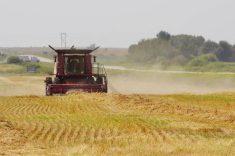Canola contracts on the ICE Futures Canada platform held within a rather tight range during the week ended Feb. 26, initially moving higher before eventually finishing the week with small losses in the nearby contracts – although the advances did hold up in the new-crop months.
The canola trade could be best described as “range bound” with no clear price direction to speak of. Improving domestic crush margins and talk of steady exporter demand provided some underlying support for canola. However, large global oilseed supplies and bearish technical signals kept values under pressure.
Read Also

Manitoba data in on Maizex canola hybrids
Maizex Seeds has two new canola hybrids for western Canadian farmers to plant for the 2026 crop. The latest Manitoba trial data is in on the new varieties.
Western barley futures also bounced around during the week, but remained in a well-established downtrend overall. A lack of aggressive end-user demand, as there are ample supplies of U. S. corn and dried distillers grains (DDGs) to be had, weighed on prices in the cash market, spilling into the futures.
For three-times-daily market reports from Resource News International, visit “ICE Futures Canada updates” at www.manitobacooperator.ca
Chicago Board of Trade (CBOT) soybean futures were also choppy and range bound, but ended the week with modest gains. Short-covering was behind some of the strength. However, expectations for a record-large South American crop remained the overarching bearish price influence, keeping values well contained.
The market on corn was looking a little stronger, with the trend definitely pointing higher during the week. While the South American corn crop is also expected to put some pressure on prices, the quality of this year’s U. S. crop is said to be questionable, which was providing some support for the futures. The technical trend lines were also said to be turning higher in corn.
U. S. wheat futures were higher in Chicago, Minneapolis and Kansas City, but were tempered on the upside by technical resistance.
At its annual Grain World conference in Winnipeg, the Canadian Wheat Board put out forecasts for the 2010-11 global wheat supply/demand situation. The board was calling for a reduction in world production to 633 million tonnes, from 651 million, but predicted that ending stocks would still increase for the third consecutive year. That ample supply situation kept the new-crop pool return outlook (PRO) on the soft side. The CWB calls for durum and barley were similar, with ample world supplies likely to weigh on prices in the upcoming year.
MURKY ECONOMICS
In listening to numerous speeches over the course of the Grain World conference, from numerous presenters, the consensus from the podium on agriculture was decidedly mixed. However, I think there were a few key ideas to come out of the conference that should deserve a good look going forward. Aside from the standard supply/demand outlooks on all of the major crops and livestock, the theme of this year’s Grain World conference was on the economy.
Depending on who you talk to, the global economy is improving, or we’re still having trouble clawing our way back up. That outlook seems to change from day to day, as equities traders look for a reason to take the stock markets one way or the other. I think one of the Grain World presenters made a good point when he noted that all of the economic forecasts were well and good, but just remember that there weren’t too many people forecasting the collapse of 2008 until after the fact. In a speech on the beef market, another presenter made the good point that the beef industry was hit by at least four unexpected shocks over the past decade, including BSE, 9/11 and the recent economic collapse. He said it could be safe to assume more surprises in the decade ahead, but also noted there are ways to prepare for such unexpected events.
So the economy is uncertain, but at least appears to be improving in some of the major export destinations for Canadian agricultural products, including China and India. That should bode well for demand, although political issues and trade barriers always have the potential to cause problems.
The currency markets are one aspect of the international financial markets of particular interest to Canadian farmers. A strong Canadian dollar makes Canadian products less attractive to international customers and also cuts into the returns seen here. The Canadian dollar projections from economists are also mixed, but in general terms, a currency holding above US90 cents seems a lot more likely in the foreseeable future than one below that level.
Looking beyond economics and the supply/demand fundamentals, the weather is one more factor that everyone seems to have an opinion on, but nobody can agree on. Dry conditions in the western Prairies and potential flooding in southern Manitoba are pretty much par for the course when it comes to spring planting, and this year appears to be no different. However, U. S. conditions will be dictating the futures market at some point, and the Midwest has seen some extensive snowfall this year.
The U. S. weather is starting to get some play in the CBOT futures markets, with the heavy snow accumulation leading to concerns about delayed plantings this spring. Any delays to spring planting in the U. S. would mean less corn going in the ground and more soybeans, which could cause those markets to adjust accordingly.
–Phil Franz-Warkentin and Dwayne Klassen write for Resource News
International (RNI), a Winnipeg company specializing in grain and commodity market reporting.















